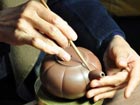| Videos | • Latest |
|
• Feature | • Sports | • Your Videos |
Take a deeper look into cultural heritage

 0 Comment(s)
0 Comment(s) Print
Print E-mail CNTV, February 17, 2012
E-mail CNTV, February 17, 2012
An exhibition of China's intangible cultural heritage has concluded at the Agriculture Exhibition Center in Beijing. The ten-day event featuring more than 180 traditional crafts and arts attracted around 170,000 visitors. People sometimes had to wait in line outside the gate.
 |
|
The woman working on the Zisha teapot is Wu Yayi, a famous Zisha craftsperson of Jiangsu Province. |
But in spite of the exhibition's success, the status quo for various traditions is not as positive as the numbers may indicate. Let's take a deeper look at the shaky situation.
The woman working on the Zisha teapot is Wu Yayi, a famous Zisha craftsperson of Jiangsu Province. She has spent thirty years making pottery works, and now most of her time has shifted to her students.
Wu Yayi said, "The students are very sincere, and very earnest. And when it comes to teaching them, so am I. I tell them all I know."
Currently Wu has some 40 students. With Zisha teapot's fame throughout the country, she does not worry about the craft's future.
However, it's another story when it comes to Chu-style lacquer wares. The traditional artwork has a 2000-year history and is found only in Jingzhou of Hubei Province. Yet people mastering the craft are becoming less and less.
|
An exhibition of China's intangible cultural heritage has concluded at the Agriculture Exhibition Center in Beijing. The ten-day event featuring more than 180 traditional crafts and arts attracted around 170,000 visitors. |
Zou Dexiang, the inheritor of the craft, says he worries a lot about the future.
Zou said, "People don't want to learn it because the craft is complex and it takes time. It may take at least three years to master the basic steps independently."
Three years do seem a long time for the low-profit and tiring work.
Most of the few students there didn't see much of a future in learning to make lacquerware, so they switched to other careers. That's the common story for Zou, and also for Yang Zhi, national craftsman of Jun Kiln Porcelain. Knowing how times have changed, Yang can only sigh.
Yang Zhi said, "I have covered 80 kilometers to look for chances, asking people whether they'd like to learn to make porcelains with me. In the past, apprentices come to masters and beg to be taught. Now time has reversed the sides."
In old times, porcelain from a "Jun Kiln" were hailed as the best of the four state-run porcelain kilns. It was once thought worthier than any other treasure one could get. That former glory has long faded.
Ma Wenhui, Director of Intangible Cultural Heritage Department at the Ministry of Culture explains the reason for the unbalanced situations.
Ma said, "It has to do with the current economic situation and aesthetic fashion. Zisha teapots are masterpieces for collecting and are still common products for daily use. What's more, people now care more about good health, so teapots rise with tea culture's revival. On the other hand, 'Jun' porcelains have a relatively narrow market."
Director Ma tells us the Ministry of Culture is working on varying methods to protect each cultural heritage according to its specific situation. A system will be built for investigating and classifying the heritage, then each category will have standard regulations to follow.
The best method of protection is to let the art become part of daily life. However, Ma says some heritages are destined to disappear. It is determined by the current way of life.
Ma Wenhui said, "Traditional art forms might disappear. But their techniques and cultural memories should be remembered. We must save the wisdom and cultural meaning of our ancestors."
History and heritage may not always guide us into the future, but from them we certainly can know how far we have come.







Go to Forum >>0 Comment(s)